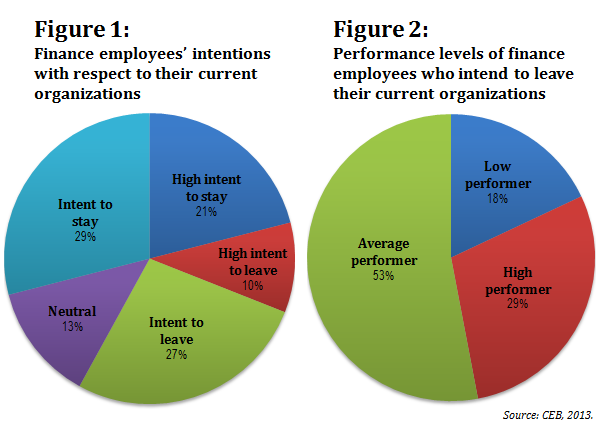 Half of all finance employees lack commitment to their current jobs, and the ones who are most likely to leave are the ones already meeting or exceeding expectations, including nearly one in three rated as high performers. At the same time, the vast majority of CFOs whom CEB surveyed as part of our Finance Talent research are already unhappy with the mix of finance talent at their disposal. They need to start doing a lot more to retain their best employees.
Half of all finance employees lack commitment to their current jobs, and the ones who are most likely to leave are the ones already meeting or exceeding expectations, including nearly one in three rated as high performers. At the same time, the vast majority of CFOs whom CEB surveyed as part of our Finance Talent research are already unhappy with the mix of finance talent at their disposal. They need to start doing a lot more to retain their best employees.
These are among the key take-aways from a recent CEB survey of nearly 700 finance managers at more than 75 companies around the world. We found dissatisfaction at both the employee and the executive level. More than one-third of finance employees said they are actively planning to leave their current jobs within a year. And more than two-thirds of those employees are either meeting or exceeding expectations, so the turnover will likely create headaches for their CFOs. (See Figures 1 and 2, below.)
The challenges will extend beyond short-term disruptions in workflow. High-performing employees typically have valuable institutional knowledge and maintain strong professional connections. They are often critical to revenue generation or product development, as well, so replacing them may be difficult. Plus, turnover among finance's high performers can present a serious risk to succession planning. As the CFO is increasingly viewed as a CEO in waiting, so finance staff is becoming an important component of companies' talent pipeline.
The typical approach to improving retention is to focus on compensation, but CEB's research indicates that this approach is incomplete. Although compensation-driven strategies attract talent, they are not the driving factor in retaining top performers. Instead, successful retention programs usually entail training and development activities, such as highly personalized coaching and well-thought-out staff rotations. In addition to boosting retention, these programs drive competency development, particularly in the “soft skills,” which our research identified as crucial differentiators for the best finance departments.
Not only does low investment in retention lead to increased turnover, but it bleeds into a myriad of other issues that can threaten the entire business: poor/deteriorating staff competencies, lack of a leadership pipeline, and low productivity levels. To retain the best and brightest on their finance teams, companies need to pursue best-practice approaches to finding, hiring, developing, and retaining key individuals.

To delineate these best practices, CEB reviewed finance employees' responses to our quarterly Global Labor Market Survey of more than 18,000 employees in 28 countries. We compared employee engagement, satisfaction, and job-seeking behaviors with factors such as compensation and career opportunities. The data revealed that finance employees' levels of engagement and satisfaction depend not just on compensation and benefits, but also on the level of impact of the job, the opportunity for skill development, and options for work-life balance.
We consistently found that best-in-class finance departments build their retention strategies around nonmonetary rewards, such as leadership opportunities and compelling career paths. They also share a commitment to investing in thoughtful, long-term development of their high-performing employees. The good news is that we were able to identify a series of transferable ideas, beyond competitive compensation, that progressive companies are already using to build a healthy talent pipeline.
1. Understand Your Retention Risk
In order to better retain key employees, senior executives need to clearly understand the factors that drive retention risk for these people. These factors vary not only from company to company, but from role to role and from employee to employee. CEB has identified two sets of risk criteria that organizations need to evaluate: position risk and individual risk.
We define position risk as the level of risk that an organization would be exposed to were it to lose any employee in a given position, regardless of that employee's performance. A job has an elevated position risk if it is:
- crucial to maintaining external relationships and partnerships,
- crucial to product development,
- crucial to revenue generation,
- crucial to strategy development and execution,
- difficult to quickly replace through external hiring,
- difficult to identify an internal successor, and/or
- senior within the organization.
Any one of the above factors means a position has elevated position risk. Two or more flag a position as meriting especially close consideration. Some of these factors have more impact within certain types of businesses, so leaders must use their judgment when assessing positions' risk within their own organization. Nevertheless, a company's executives should be able to reach consensus on which positions require the most attention in retention efforts.
Determining individual risks can be more subjective if a company doesn't have the right processes in place. We define individual risk as the level of risk that an organization would be exposed to if it lost a specific, named employee who holds a key position. This type of risk divides along two broad subsets of risk factors: How well the employee is performing and whether the employee is happy. To identify which individuals are high performers, a CFO should answer several questions:
- Has the employee been designated formally as a high performer (HIPO) or a potential HIPO?
- Is the individual a named successor to any of the company's executive-level roles?
- Is the individual a critical conduit for information within the organization?
- Does the individual possess a high degree of valuable institutional knowledge or functional expertise?
If the answer to any of the above questions is yes, the CFO should immediately evaluate how satisfied the employee is within the organization, and how likely he/she is to remain that way. This evaluation may be as simple as considering the length of the employee's daily commute, or it may be a complex analysis of the possible directions the employee's career path might take within the company. Questions to ponder include:
- Is the employee's total compensation package equitable in the current market?
- What kind of development opportunities are available to him/her?
- Has the employee recently been dissatisfied with a promotion or a performance review?
- How good is the employee's relationship with his/her direct manager?
- Has the employee's performance been improving or declining?
- Are we aware of any personal factors (such as commute) that may influence whether the employee decides to stay or leave?
CFOs must be ready to act when they identify a key employee with elevated levels of both position risk and individual risk. A normally functioning business will have only a handful of these “double-risk employees.” According to our research, companies need to make aggressive plans for retention when an individual simultaneously faces just one factor in each set.
2. Invest to Get Employees Invested
Many CFOs who believe that soft skills are important fail to invest substantially in improving these skills for their staff. CEB's research indicates that even among finance teams that see themselves as business partners, fewer than half invest in programs designed to build employees' business acumen, such as structured coaching or rotation programs.
To understand the importance of soft skill development, CEB researched the impact of more than 100 finance staff competencies on the effectiveness of the overall finance department. We grouped these skills into five categories: builder competencies, persuader competencies, strategist competencies, learner competencies, and doer competencies. The last two categories—learner and doer competencies, marked by strong functional execution—turned out to have surprisingly little effect on the finance function's effectiveness. Instead, the builder, persuader, and strategist competencies—all marked by the presence of soft skills, such as communication skills and team building—served as the clearest drivers of departmental effectiveness.
This “pathfinder” skill set, representing the nontechnical competencies of the finance function, is what finance leaders need to be most conscious of as they develop the talent mix on their teams. We found that the best companies not only implement soft skills development programs, but ensure that these programs rapidly increase learning among high-performing employees and bring them closer to the business.
 One well-known technology company develops finance employees' business acumen and other soft skills through a structured, three-year rotation program. Participants are all entry-level finance staff, who move rapidly through different functions and business units in order to develop into well-rounded finance employees. Senior executives coach participants on at least a quarterly basis. At the end of their three years in the program, participants are placed in the organization based on business needs, input from coaches, and the participants' areas of interest. The innovative program provides the company with a pipeline of talented staff who can effectively deal with a changing and complex business environment. It also helps the company increase retention rates while evaluating high performers' potential as future finance leaders.
One well-known technology company develops finance employees' business acumen and other soft skills through a structured, three-year rotation program. Participants are all entry-level finance staff, who move rapidly through different functions and business units in order to develop into well-rounded finance employees. Senior executives coach participants on at least a quarterly basis. At the end of their three years in the program, participants are placed in the organization based on business needs, input from coaches, and the participants' areas of interest. The innovative program provides the company with a pipeline of talented staff who can effectively deal with a changing and complex business environment. It also helps the company increase retention rates while evaluating high performers' potential as future finance leaders.
There is no question that such a program requires substantial investment of time, personnel, and capital. The size of that investment depends on several factors, including the number of participants, the organizational structure, and the type of rotation exposure. A finance function looking to implement a rotation program may consider four types of rotations: intra-departmental movement, transfers between finance and the business units, moves between regional finance teams and the corporate finance function, and geographic rotations. Large-scale and international rotations are the most costly, and they may be out of reach for some companies. It is important for executives to think carefully about what type of rotation, if any, would best improve competency and career satisfaction within their organization.
For the technology company, the rotation program's return on investment has been evident. The program simultaneously builds participants' internal networks and competencies that help them understand the business. Graduates of the program are twice as likely to be rated high performers as is the average new hire, so the program is helping build a deep bench of future finance leaders.
3. Match Potential Leaders to Highly Demanding Roles
Since 2009, leadership investment for the middle management layer has declined by 20 percent, which has led to a lack of finance managers who are prepared to take on new responsibilities and develop junior staff. The most successful companies rigorously manage the learning and performance of top finance staff.
\For example, one multinational uses the concept of “crucible roles,” which it defines as complex, highly demanding roles that have a high business impact. The company reserves these positions for individuals it has identified as up-and-coming leaders in order to engage and retain them. Make no mistake: These are not “laboratory” assignments; they are key marketing and brand-management positions associated with crucial brands or geographic markets within the company's portfolio. In fact, because the crucible roles are so critical to the business, the company has developed a highly structured support system for these high performers. Senior leaders take responsibility for introducing them to key colleagues across the business, while managers monitor their engagement via regular, informal check-ins.
With this support structure in place, individuals in crucible roles are held to a higher standard. They are expected to consistently outperform their peers by a significant margin, while rapidly acquiring new skills. After a period of three years, typically, a high performer who has extracted the full learning value from a crucible role is rotated to a very different position to continue leadership development. Employees who underperform in the program are moved to non-crucible roles that better suit their abilities.
Throughout the process, managers work hard to match high-potential employees with crucible roles that suit their career goals. Not surprisingly, this program has resulted in a notable improvement in the engagement, productivity, and retention of critical finance talent within this company.
Other organizations can take a similar approach by systematically assessing positions for their business impact and complexity, then matching high-performing employees to those roles. Two questions can provide a litmus test to identify roles with both complexity and high impact:
- If the person in this role is unsuccessful, is there significant risk to the business?
- Does the person in this role need to master a broad range of skills?
If the answers to both questions are “yes,” the position is likely a crucible role.
A Retention Program that Works for Your Business
It's clear from our research that the past several years have been trying for both CFOs and their employees. It's also clear that the best companies are taking action to redress this dissatisfaction, and they're starting with their most valuable employees.
There are many ways to raise engagement and satisfaction levels among high-performing and high-potential staff. Launching a global rotation program or a structured “crucible role” system may not be feasible for your company. The most effective businesses create appropriate programs that work well within their corporate culture. Most utilize the network of senior leaders that the organization already has in place. Many also encourage collaboration across the business, whether formally or informally.
Retaining high-performing employees is an investment in the organization's future leadership, and successful companies build bridges to help today's high performers reach tomorrow's boardroom. As the economy enters a new phase, finance departments that succeed in retaining high performers will be able to turn their attention to transformative business goals. Those that don't may see an already-frustrating talent situation get a lot worse.
See the sidebar:
—————————————–
 Kruti Bharucha is senior director at CEB. She leads CEB's research on The New Finance Skill Set—Hiring, Developing and Managing the Finance Competencies that Matter Most.
Kruti Bharucha is senior director at CEB. She leads CEB's research on The New Finance Skill Set—Hiring, Developing and Managing the Finance Competencies that Matter Most.
Complete your profile to continue reading and get FREE access to Treasury & Risk, part of your ALM digital membership.
Your access to unlimited Treasury & Risk content isn’t changing.
Once you are an ALM digital member, you’ll receive:
- Thought leadership on regulatory changes, economic trends, corporate success stories, and tactical solutions for treasurers, CFOs, risk managers, controllers, and other finance professionals
- Informative weekly newsletter featuring news, analysis, real-world case studies, and other critical content
- Educational webcasts, white papers, and ebooks from industry thought leaders
- Critical coverage of the employee benefits and financial advisory markets on our other ALM sites, PropertyCasualty360 and ThinkAdvisor
Already have an account? Sign In Now
*May exclude premium content© 2025 ALM Global, LLC, All Rights Reserved. Request academic re-use from www.copyright.com. All other uses, submit a request to [email protected]. For more information visit Asset & Logo Licensing.





